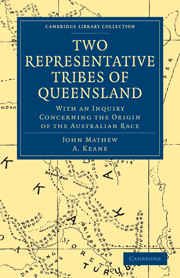 Two Representative Tribes of Queensland
Two Representative Tribes of Queensland Book contents
- Frontmatter
- Contents
- LIST OF ILLUSTRATIONS
- INTRODUCTION
- PREFACE
- CHAP. I INQUIRY CONCERNING THE ORIGIN OF THE AUSTRALIAN RACE
- CHAP. II THE COUNTRY OF THE KABI AND WAKKA TRIBES
- CHAP. III PHYSICAL AND MENTAL CHARACTERS
- CHAP. IV DAILY LIFE—SHELTER—FOOD—CLOTHING
- CHAP. V MAN-MAKING AND OTHER CEREMONIES
- CHAP. VI DISEASE AND TREATMENT—DEATH—BURIAL AND MOURNING
- CHAP. VII ART—IMPLEMENTS—UTENSILS—WEAPONS—CORROBOREES
- CHAP. VIII SOCIAL ORGANISATION
- CHAP. IX THE FAMILY—KINSHIP AND MARRIAGE
- CHAP. X RELIGION AND MAGIC
- CHAP. XI MYTHS AND LEGENDS
- CHAP. XII LANGUAGE
- VOCABULARY
CHAP. VIII - SOCIAL ORGANISATION
Published online by Cambridge University Press: 29 August 2010
- Frontmatter
- Contents
- LIST OF ILLUSTRATIONS
- INTRODUCTION
- PREFACE
- CHAP. I INQUIRY CONCERNING THE ORIGIN OF THE AUSTRALIAN RACE
- CHAP. II THE COUNTRY OF THE KABI AND WAKKA TRIBES
- CHAP. III PHYSICAL AND MENTAL CHARACTERS
- CHAP. IV DAILY LIFE—SHELTER—FOOD—CLOTHING
- CHAP. V MAN-MAKING AND OTHER CEREMONIES
- CHAP. VI DISEASE AND TREATMENT—DEATH—BURIAL AND MOURNING
- CHAP. VII ART—IMPLEMENTS—UTENSILS—WEAPONS—CORROBOREES
- CHAP. VIII SOCIAL ORGANISATION
- CHAP. IX THE FAMILY—KINSHIP AND MARRIAGE
- CHAP. X RELIGION AND MAGIC
- CHAP. XI MYTHS AND LEGENDS
- CHAP. XII LANGUAGE
- VOCABULARY
Summary
The term tribe as applied to the aborigines is somewhat vague. It has no reference to numbers, or extent of territory, or political unity. The bond of tribal affinity, that has generally been recognised, is community of language. This is invariably the strongest bond, and involves and implies other factors making for union. There was no chieftain, no organised government. There are no chiefs, in the ordinary application of the word, in Australia. A few families claiming the same territory usually camped and travelled together, sometimes in smaller, sometimes in larger numbers. I characterise such family groups as communities. Dr Howitt's Kaiabara was merely a group like this and not a tribe. He locates it at Widgee, whereas the name I got for the Widgee people was Gīgarbŏra. On his map its locality is placed near the Boyne River, in the Wakka country, where it could not possibly have its home. Its habitat was probably somewhere a little to the south of Widgee. Communities designated by some feature distinguishing either themselves or their country, the term for which was prefixed to the termination -bŏra, were, apparently, more numerous among the Kabi people than in any other tribe. But such communities were constituted by a few families occupying the same small area in common.
- Type
- Chapter
- Information
- Two Representative Tribes of QueenslandWith an Inquiry Concerning the Origin of the Australian Race, pp. 128 - 152Publisher: Cambridge University PressPrint publication year: 2010First published in: 1910


